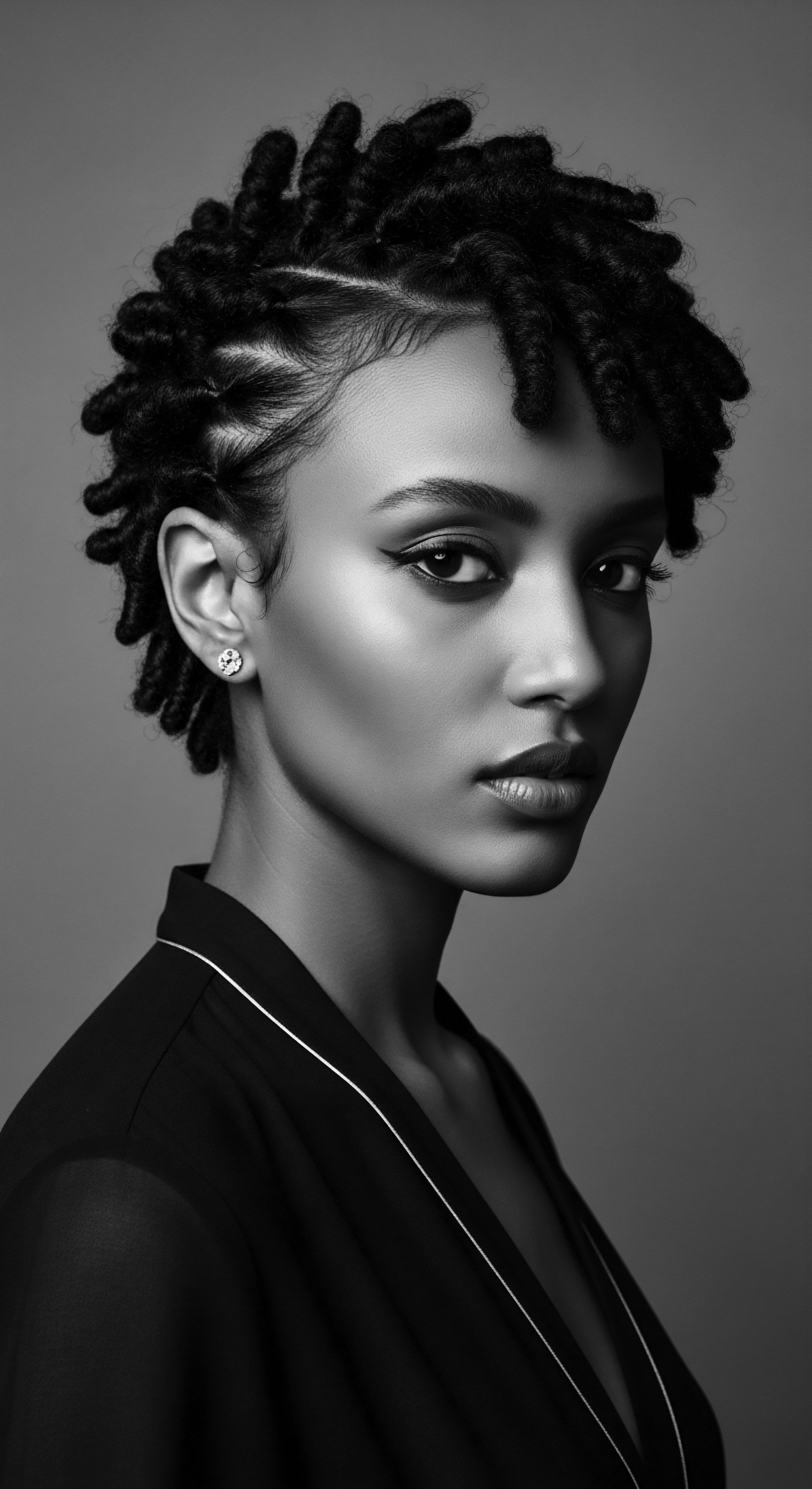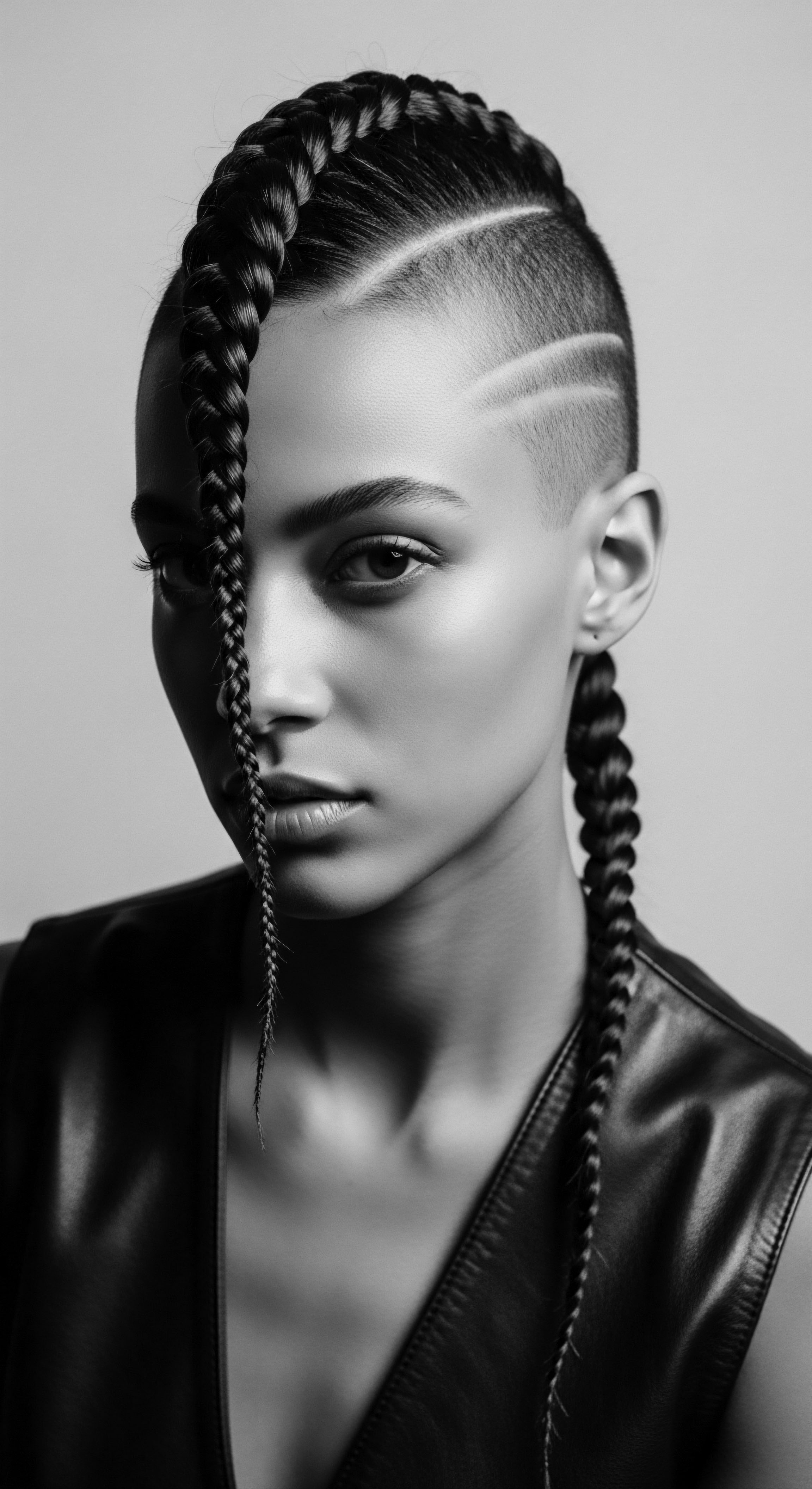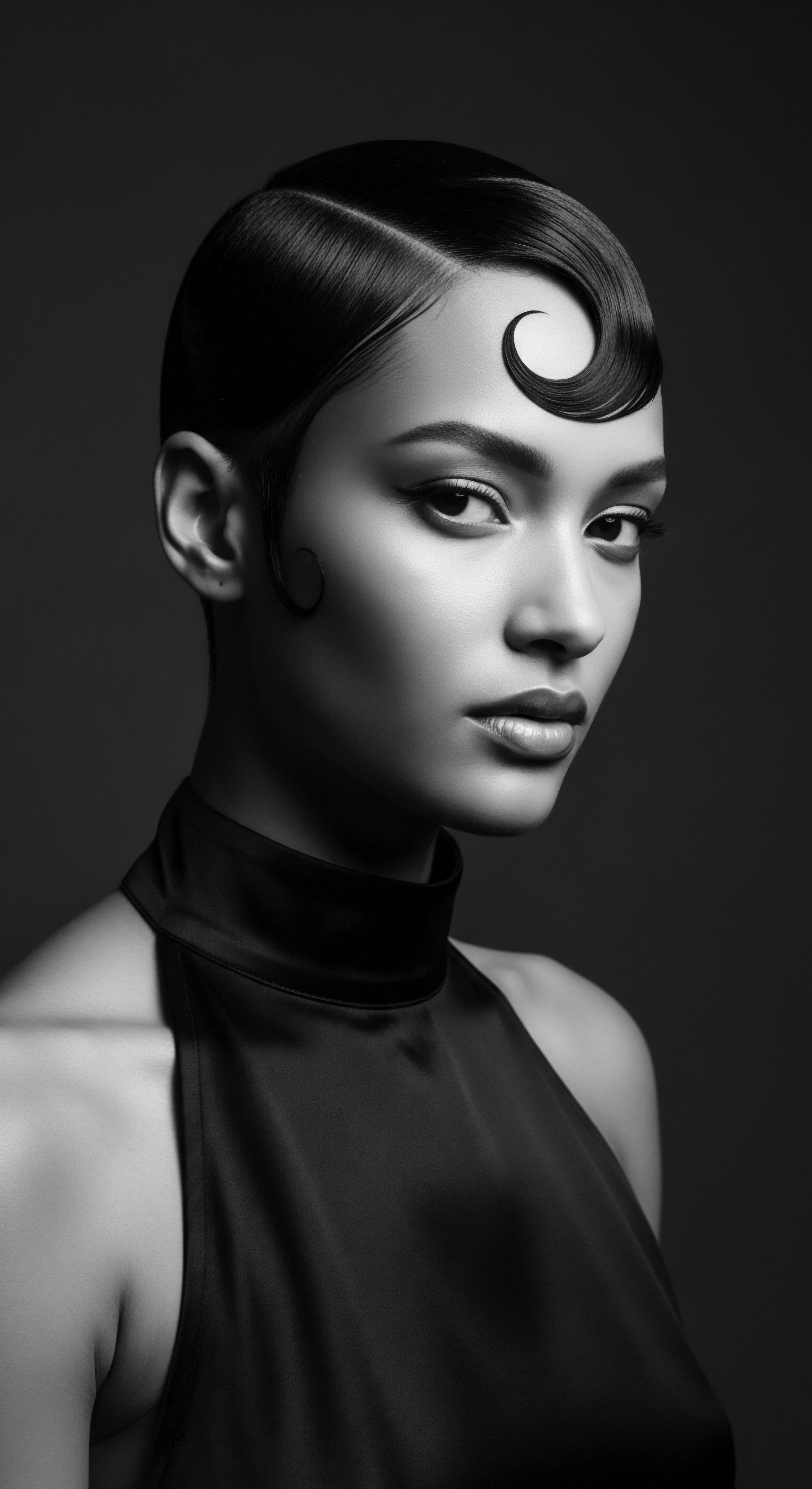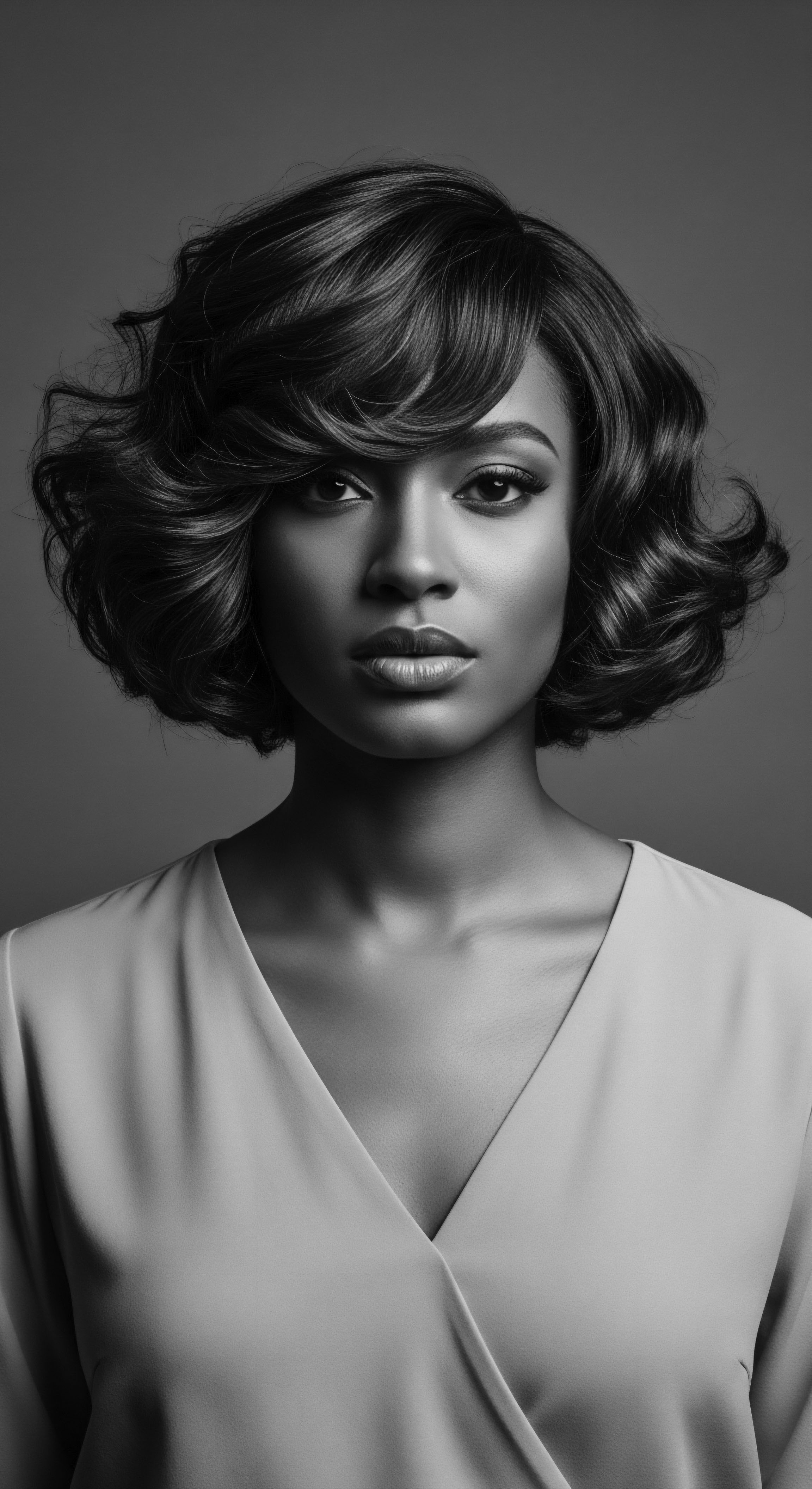
Roots
For those who wear the crown of textured hair, the story of its care is not a fleeting trend, nor a mere cosmetic pursuit; it is a resonant conversation across generations, an unbreakable chain of wisdom passed down through the ages. Each coil, every curl, holds within its very structure the whispers of ancient hands, the resilience forged in distant lands, and the quiet triumph of traditions that refused to be forgotten. To truly understand how historical practices shape the care we give our hair today, we must first look to the elemental, to the very blueprint of the strand itself. This is where heritage begins, not as an abstract idea, but as a living, breathing part of our biological inheritance.
The fundamental architecture of textured hair carries the indelible marks of ancestral environments and care, a silent library of inherited wisdom.

Hair Anatomy and Its Ancestral Echoes
The distinct morphology of textured hair, from its elliptical cross-section to the often varied distribution of disulfide bonds along its length, is a marvel. Unlike straight hair, which tends to be round in cross-section, the flattened or oval shape of the textured hair follicle dictates the spiral growth pattern, creating the characteristic curls, coils, and kinks that define its beauty. This unique structure, while contributing to the hair’s magnificent volume and expressive versatility, also renders it more prone to dryness and fragility compared to straighter hair types (Gavazzoni, 2017).
This predisposition to dryness is significant; it is a biological reality that compelled our ancestors to devise practices centered on moisture retention and gentle handling. Their ingenuity, born from observation and necessity, gave rise to a legacy of oiling, sealing, and protective styling.
Consider the hair’s outermost layer, the cuticle. In highly coiled or kinky hair, these protective scales tend to be fewer in number and often lifted, rather than lying flat against the cortex. This openness, a direct consequence of the hair’s tight curvature, allows moisture to escape more readily and makes the strands more susceptible to environmental aggressors and physical friction.
Ancestral practices like the use of plant-derived emollients and the crafting of elaborate updos served not only aesthetic purposes but functioned as ingenious forms of defense against the elements, minimizing exposure and locking in vital hydration. These methods were not just beauty rituals; they were acts of biological understanding, albeit without modern scientific terminology.

How Have Historical Classification Systems Shaped Understanding?
For generations, the language used to categorize textured hair has been fraught with complexities, often mirroring societal biases rather than purely scientific observation. Early anthropological attempts to classify hair types frequently intertwined with racial hierarchies, creating problematic frameworks that persist in subtle ways even today. Yet, within many traditional African and diasporic communities, hair was not categorized by a numerical system, but rather by its visual characteristics, its feel, and its growth pattern, often given poetic or descriptive names that spoke to its inherent qualities and spiritual significance.
- Twa ❉ A traditional term in some West African cultures, describing tightly coiled hair, often associated with spiritual connection and wisdom.
- Sankofa ❉ While a broader concept meaning “go back and get it,” it implicitly refers to retrieving ancestral knowledge, including that of hair textures and their care.
- Koroba ❉ A Yoruba term for a particular type of braided style, highlighting how hair classification was often tied to styling traditions and cultural expressions.
The later advent of numerical classification systems, while attempting scientific objectivity, often inadvertently reinforced a continuum that placed straighter hair at one end and highly coiled hair at another, sometimes implying a hierarchy. This historical lens reveals that the contemporary dialogue around hair typing, though now often used positively for care guidance, still carries the faint echo of these past categorizations. Understanding this heritage allows us to critically approach modern systems, appreciating their utility while remaining mindful of their historical baggage.

Hair Growth Cycles and Ancient Influences
The fundamental phases of hair growth—anagen (growth), catagen (transition), and telogen (rest)—are universal, yet external factors throughout history have always played a role in how vigorously these cycles progressed. Ancestral diets, rich in nutrient-dense whole foods like leafy greens, root vegetables, and lean proteins, naturally supported hair health from within. Communities living closer to the earth, consuming diets unburdened by processed foods, likely experienced less systemic inflammation, which is known to impact follicle health and hair shedding today.
Furthermore, environmental factors like climate and access to clean water also historically shaped hair care. In arid regions, the emphasis on heavy oils and butters was paramount to shield the hair from desiccation. In more humid environments, lighter infusions and frequent cleansing might have been favored.
These environmental adaptations, refined over centuries, formed the bedrock of hair care wisdom, demonstrating a profound understanding of localized resources and their direct impact on the hair’s life cycle. Our current knowledge of hair porosity and the need for protein-moisture balance, while couched in scientific terms, often validates these time-tested solutions that emerged from our forebears’ lived experiences.

Ritual
From the very architecture of the strand, our gaze now turns to the artistry and intention of how hair has been adorned, shaped, and guarded through the ages. The methods and instruments used to manipulate textured hair were never simply utilitarian; they were imbued with cultural meaning, spiritual significance, and a profound understanding of what the hair needed to thrive. Contemporary styling practices, often celebrated for their innovation, often find their clearest reflections in the ingenuity of our ancestors. The question is not whether historical practices influence our present choices, but how deeply their roots anchor our current artistry.
Traditional styling techniques, rooted in practical necessity and cultural expression, serve as foundational blueprints for many modern textured hair aesthetic pursuits.

Protective Styling Its Ancient Pedigree
Protective styles, a cornerstone of contemporary textured hair care, possess a lineage stretching back millennia, serving as both artistic expression and practical preservation. Braiding, for example, holds a history that predates recorded time, with archaeological evidence of braided hair dating back as far as 30,000 years in certain African contexts (Byrd & Tharps, 2014, p. 14). These were not casual adornments; specific braid patterns often signified marital status, age, community affiliation, or social standing.
The cornrow, known for its scalp-hugging precision, was, in some cultures, a mapping of escape routes for enslaved people, a hidden message in plain sight (Walker, 2017). This profound history means that when we choose cornrows or box braids today, we are not simply opting for a convenient style; we are engaging in a dialogue with a powerful ancestral legacy of resilience and communication.
The concept was simple yet brilliant ❉ minimize manipulation, shield vulnerable ends, and allow the hair to rest and grow. This insight into reducing stress on the hair shaft, which contemporary trichology affirms as crucial for length retention, was intuitively understood by those who practiced these styles. Today’s twist-outs, Bantu knots, and various braided styles are direct descendants of these methods, adapted for modern aesthetics but retaining the core principle of protection. The tools might have evolved from bone combs and natural fibers to plastic and synthetic extensions, yet the underlying wisdom remains the same.
| Historical Implement or Technique Bone Combs used for parting and detangling. |
| Contemporary Parallel or Influence Wide-Tooth Combs and finger detangling methods for minimizing breakage. |
| Historical Implement or Technique Herbal Infusions & Butters for cleansing and conditioning. |
| Contemporary Parallel or Influence Sulfate-Free Cleansers and deep conditioning treatments with botanical extracts. |
| Historical Implement or Technique Tight Braiding Patterns as a form of communication or mapping. |
| Contemporary Parallel or Influence Protective Styles like cornrows and knotless braids for hair health and aesthetic. |
| Historical Implement or Technique The continuity of purpose from ancient tools to modern innovations highlights an enduring understanding of textured hair's unique needs. |

Natural Styling How Far Back Does Definition Go?
The pursuit of definition and vibrancy in textured hair is hardly a recent phenomenon. Long before styling gels and creams, ancient African communities employed natural ingredients to enhance the coil pattern and maintain moisture. Plant mucilages from okra or flaxseed were likely used to provide hold and gloss.
Shea butter and other natural oils, worked into the hair, not only softened the strands but also helped clump curls, giving them a more defined appearance. The visual aesthetic of a well-defined coil was not merely about beauty; it often symbolized health, vitality, and proper care.
The ritual of finger coiling or shingling, now popularized in the natural hair movement, finds its precursor in the meticulous manual manipulation of strands to encourage definition. This hands-on approach reflects a deep, intimate relationship with one’s hair, a practice of patience and intentionality. The techniques for creating shape and form were passed down orally, learned by observation, and perfected through generations, forming a collective ancestral memory of what works best for various hair types.

Wigs and Hair Extensions Their Historical Place?
The use of wigs and hair extensions, often perceived as modern accessories, carries a rich historical tradition within African cultures, dating back to ancient Egypt. Egyptians, both men and women, wore elaborate wigs made from human hair, plant fibers, or even wool, often adorned with beads and jewels. These served practical purposes, protecting the scalp from the sun and preventing lice, but were also potent symbols of status, wealth, and spiritual connection. (Auzias & Beau, 2018).
Beyond Egypt, various African societies used extensions made from natural fibers, sometimes integrated into intricate braided or woven styles, to signify rites of passage, marital status, or tribal identity. The practice of adding hair, whether for volume, length, or structural integrity, was a customary aspect of hair artistry, reflecting adaptability and creativity. This historical context provides a grounding perspective for the contemporary use of weaves, braids with extensions, and wigs, reminding us that these choices are not just fashion statements, but echoes of a profound cultural heritage.

Relay
Our exploration deepens, moving from the foundational anatomy and artistic manipulation to the profound daily rhythms of care, those intimate rituals that safeguard and replenish the textured strand. Here, the ancestral wisdom, honed by observation and inherited knowledge, directly informs contemporary approaches to hair health and problem-solving. This is where science often validates what our forebears understood through lived experience, revealing a continuous chain of insight. The question then becomes ❉ How precisely do these ancient practices continue to guide our understanding of optimal care for textured hair in the present moment?
The enduring legacy of ancestral hair care practices provides a rich framework for contemporary holistic wellness, offering time-tested solutions for common textured hair concerns.

Building Regimens Does Ancestral Wisdom Guide Us?
The concept of a “regimen,” a structured routine for hair care, is far from new. Though not codified with morning and evening steps in a precise written manual, ancestral communities maintained consistent practices for cleansing, moisturizing, and protecting their hair. These practices were intrinsically tied to the rhythm of life, the availability of natural resources, and communal ceremonies.
For instance, in many West African societies, the application of various plant butters like shea and cocoa, or oils from coconut and palm, was a daily or weekly ritual (Okunola, 2016). This sustained layering of emollients and humectants directly addresses the inherent dryness of textured hair, a practice validated by modern science which emphasizes sealing moisture into the cuticle.
The deliberate choice of cleansing agents also reflects this continuum. While modern shampoos offer a wide array of formulations, the historical use of natural saponins from plants like soapberry or aloe vera for gentle cleansing aligns perfectly with the contemporary emphasis on sulfate-free and low-lather cleansers, designed to strip less of the hair’s natural oils. The continuity lies in the shared objective ❉ to clean effectively without compromising the hair’s delicate moisture balance.

The Nighttime Sanctuary How Has Bonnet Wisdom Evolved?
The seemingly simple act of covering hair at night with a silk or satin bonnet, a commonplace practice today, possesses an ancient heritage of protection and preservation. While the exact form of “bonnets” might have varied across historical periods and regions, the concept of safeguarding hair during sleep was universally understood. In many traditional African societies, head coverings, often made from soft cloths or wraps, were worn during sleep not only for warmth but also to prevent tangling, breakage, and moisture loss against coarse sleeping surfaces. This intuitive understanding of friction’s damaging effect on hair predates modern scientific studies on cuticle abrasion.
These nighttime rituals were also often accompanied by the reapplication of light oils or butters, ensuring the hair remained supple overnight. The communal act of braiding or twisting hair before sleep, a practice still prevalent in many homes, further testifies to this inherited wisdom, minimizing knots and maintaining style integrity. The modern silk bonnet, therefore, is not an invention out of thin air, but a direct evolution of a deeply ingrained ancestral habit, adapted for contemporary materials but serving the identical, vital purpose of protecting the precious strands.

Ingredient Deep Dives Their Ancestral Roots?
The ingredients we champion for textured hair today often mirror those revered by our ancestors, though our understanding of their molecular mechanisms has certainly deepened.
- Shea Butter ❉ Known in West Africa for millennia, this rich butter from the karite tree was used extensively for skin and hair. Its high concentration of fatty acids and vitamins A and E make it a powerful emollient and anti-inflammatory, precisely why it remains a staple for intense moisture and scalp health.
- Coconut Oil ❉ A dominant oil in tropical regions, particularly in Southeast Asia and parts of Africa, coconut oil’s unique molecular structure allows it to penetrate the hair shaft, reducing protein loss (Rele & Mohile, 2003). This scientific validation explains its historical efficacy as a pre-shampoo treatment and deep conditioner.
- Aloe Vera ❉ Used across various ancient civilizations for its healing properties, aloe vera’s mucilaginous gel provides hydration and soothing benefits for both scalp and hair. Its enzymes gently cleanse while its polysaccharides offer conditioning, a combination appreciated long before chemical analyses.
The discernment of which plants, oils, or clays to use was not random; it was a cumulative knowledge passed down, tested through generations of practical application. The efficacy of these traditional ingredients, now often lauded by scientific research, underscores the profound wisdom embedded in ancestral pharmacopeia.

Textured Hair Problem Solving Does History Hold Solutions?
From dryness and breakage to scalp irritation, many of the challenges faced by textured hair wearers today are not new. What is striking is how historical practices often offered pragmatic, sustainable solutions, many of which remain pertinent. For instance, persistent dryness, a characteristic concern for many textured hair types, was often addressed through consistent oiling, layering, and protective styles. This approach stands in contrast to the modern inclination towards chemical treatments or excessive heat, which can exacerbate the issue.
For scalp health, a clean, balanced environment was paramount. Traditional remedies for itching or flaking often involved herbal rinses (such as those from neem or rosemary) with antiseptic and soothing properties, or the application of anti-inflammatory clays. These practices speak to a holistic approach, viewing the scalp not in isolation but as an integral extension of overall hair health.
The challenges of tangling and knotting, especially prevalent in highly coiled hair, were mitigated by routine detangling with natural combs and fingers, coupled with moisture-rich emollients, practices still recommended by contemporary stylists. These historical remedies, often simple and plant-based, offer a powerful reminder of the efficacy found in natural solutions and gentle care.

Reflection
The journey through the intricate world of textured hair, from its elemental biological truths to the vibrant tapestry of its care, culminates in a profound understanding ❉ that the present is but an echo of the past, and the future, a continuation of that enduring rhythm. Roothea’s ‘Soul of a Strand’ ethos finds its deepest expression here, recognizing that every act of care, every chosen style, carries within it the memory of ancestors, the resilience of communities, and the boundless creativity born of necessity and celebration. The ways historical practices influence contemporary textured hair care are not merely academic points; they are the very heartbeat of a living heritage, pulsating through generations.
This journey reveals a remarkable continuum. The biological predisposition of textured hair for dryness, for instance, drove ancient hands to perfect the art of moisture retention through oils and butters, practices that today form the bedrock of our conditioning regimens. The need for protection against environmental stresses and breakage led to ingenious braiding and wrapping techniques, which now grace runways and everyday life alike, often without full awareness of their deep historical pedigree.
Furthermore, the cultural significance of hair as an identity marker, a symbol of status, or a medium for storytelling, remains as powerful today as it was in ancient civilizations. When we consciously choose a style or a product that honors these traditional principles, we are not just caring for our hair; we are engaging in an act of remembrance, a celebration of inherited wisdom.
The enduring influence is a testament to the fact that true understanding of textured hair is incomplete without acknowledging its deep past. It is a call to recognize that the strength, beauty, and versatility of our strands are not just genetic gifts, but also the living archive of practices perfected over millennia. As we look forward, the exploration of textured hair care continues to draw from this rich wellspring, promising innovations that, when guided by respect for heritage, will allow the unbound helix to truly flourish, connecting us ever more deeply to the soulful narrative of our origins.

References
- Auzias, D. & Beau, L. (2018). Le Petit Futé Égypte. Nouvelles Éditions de l’Université.
- Byrd, A. D. & Tharps, L. D. (2014). Hair Story ❉ Untangling the Roots of Black Hair in America. St. Martin’s Griffin.
- Gavazzoni, M. (2017). The Science of Hair Care. Allured Business Media.
- Okunola, J. A. (2016). African Hair Braiding ❉ An African American Culture, Health, and Well-Being. The Ohio State University.
- Rele, V. R. & Mohile, R. B. (2003). Effect of mineral oil, sunflower oil, and coconut oil on prevention of hair damage. Journal of Cosmetic Science, 54(2), 175-192.
- Walker, A. (2017). African Americans on Album Covers ❉ A Cultural History. University Press of Mississippi.
